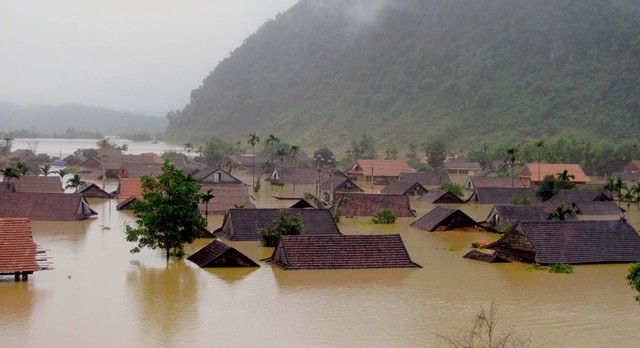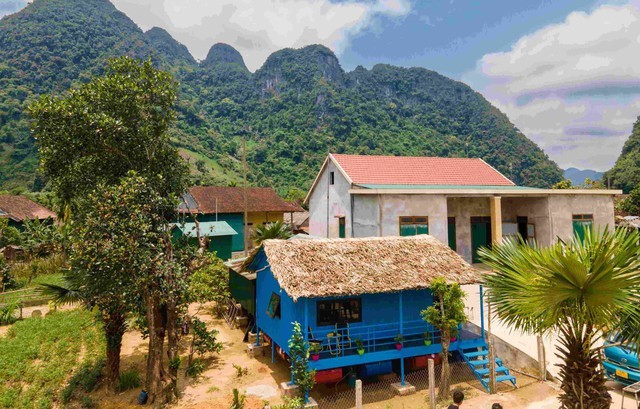On 19th October Tan Hoa village in Quang Binh province was named Best Tourism Village 2023 by the UN World Tourism Organisation (UNWTO). The award is attributable to a joint effort by local people and authorities and travel agents to turn Tan Hoa, a seasonal flood zone, into a bright spot of Vietnamese tourism.

Tan Hoa village is considered a flood center in Quang Binh province. (Photo: baochinhphu.vn)
Tan Hoa, a remote mountain commune near Phong Nha-Ke Bang National Park, is surrounded by limestone mountains and cave systems.
Dr. Nguyen Ngoc Huy, an expert on climate change and natural disaster risk reduction, said, “There are many unique things in this commune surrounded by mountains, with sharp peaks above primeval forests. Below is a flat area where people began to live about 300 years ago. Some wooden houses in there are more than half a century old. They stand beside more recently-built floating houses.”
Tan Hoa is humid all year round, with lots of rain in the hot summer and extremely cold weather in the winter. The diversity of weather is a great advantage for growing crops.
But Tan Hoa is frequently hit by floods in the rainy season. In 2010 the water level rose12 meters, submerging most of the houses and forcing the villagers to evacuate to the mountains until the water receded.
Since then Tan Hoa has been called the “seasonal flood zone”. After that historic flood, villagers started making inflatable rafts to help them survive future floods. In 2012, they developed their rafts into floating houses which help them maintain some normalcy during periods of flood.

A homestay under the weather-adaptive tourism model in Tan Hoa. (Photo: baochinhphu.vn)
Nguyen Chau A, Director General of Oxalis Adventure, a local tour operator, said Tan Hoa has 700 households who have built floating houses and have been living with the floods.
“No matter how deep the flood, they remain safe and live comfortably. They have stores of food and boats to move between their floating houses and other places,” said Chau A.
Tan Hoa villagers used to live mainly by growing rice and raising cattle. But their lives have changed a lot since 2011 when the Quang Binh administration began to pilot discovery tours. In 2014 Tu Lan cave was officially opened to the public.
Quang Binh has coordinated with travel agents to develop a strategy for Tan Hoa under which the locals do tourism in collaboration with tour operators. They are mastering service skills and designing new tours of the Tu Lan cave system and off-road motorbike tours of the Lim Forest.
Tan Hoa’s tourism model has generated stable jobs for more than 100 local workers, who are trained to do logistics work and serve Tu Lan tour customers. Villager Cao Van Thanh said, “In the past, I did farm work and went to Ho Chi Minh City as a hired worker. But as soon as I knew there was a travel agent in my hometown, I applied for a job there. It has been 5 years now. I do logistics work – cooking and providing tents for guests.”
With a monthly income of up to 330 USD for 14-16 working days per month, the locals can do tourism and still have time to do their farm work.

The Tu Lan cave system attracts a great number of domestic and foreign tourists. (Photo: baochinhphu.vn)
Tan Hoa is oriented to a weather-adaptive tourism model, offering a variety of experiences from homestays to farming to souvenir stalls.
A model involving ten homestay locations has been piloted and will open this month. The floating house homestays will book guests whenever there is a flood, to show tourists how the locals survive natural disasters. Each household expects to accommodate guests 15-20 nights per month, earning about 490 USD.
Ho An Phong, Deputy Chairman of the Quang Binh provincial People's Committee, said that the UN World Tourism Organisation’s recognition creates a foundation for the Tan Hoa to develop tourism.
“If Tan Hoa promotes itself well, it will attract many tourists, which will benefit the villagers. We’ll try to make Tan Hoa a bright spot in tourism, raise people's awareness of the importance of preserving the environment and protecting nature, and make people understand the importance of economic development that preserves the wild, rustic, peaceful look of the area,” said An Phong.
Le Phuong